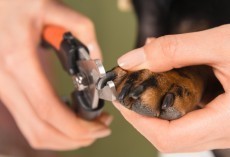If the unthinkable happens and you have to perform CPR on your pet, have someone drive you to the veterinary hospital while you are performing CPR. Also, have your friend call the hospital so they'll know you're on your way. Try to stay calm while you perform CPR on your pooch and she should be revived because you took the time to learn this vital life-saving procedure!
How to check vital signs
• For small and medium-sized dogs, normal vitals are: Pulse: 70-140 beats per minute Respiratory rate: 15-30 breaths per minute Temperature: 100-102.5° F
• For larger dogs, normal vitals are: Pulse: 50-120 beats per minute Respiratory rate: 15-30 breaths per minute Temperature: 100-102.5° F
How to give CPR to your Dog
So, now that you know how to check vitals, what do you do if you can’t feel a heartbeat? Before starting chest compressions, be certain that there is no heartbeat. Performing chest compressions while the heart is still beating can cause extreme harm to your pet.
Signs of cardiopulmonary arrest include:
• Unconscious
• Not breathing
• No heartbeatTo start chest compressions, follow these steps:
1. Put your dog or cat on their right side.
2. Interlock your fingers with both palms facing down to administer compressions. Give 1-2 compressions per second (100-120 beats per minute) for 30 seconds.
3. If your dog is < 30 pounds, make sure to do the chest compressions directly over the area of his heart.
4. If your dog is > 30 pounds, do the chest compressions on the widest part of his chest cavity as demonstrated here.
5. Next, you need to give a “mouth-to-snout” breath. Do this by wrapping both of your hands tightly around your dog’s muzzle so no air can escape. Give five breaths of five seconds each by blowing directly and steadily into his nose.
6. Repeat steps 1 and 2 until your pet’s heart starts beating on its own.
7. Most importantly, get to a veterinarian right way. Ideally, have someone drive you so you can continue CPR.
8. Ideally, call ahead on your cell phone to the veterinary hospital, so they’re prepared for your arrival.
Spread the word to your friends and family that they should enroll in a CPR class too. Dog Tube also has links to different articles on the American Red Cross' site and videos if you're more of a visual person.










Linda DeBona
- Edit
Very interesting article(s).